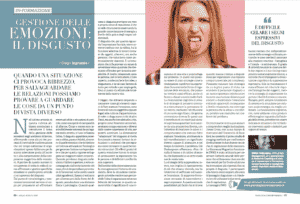
Companies for a smile
5 February 2020
THE MANAGEMENT OF CONFLICT
7 March 2020MANAGEMENT OF EMOTIONS: DISGUST

Column “PSYCHOLOGY OF EMOTIONS” by Diego Ingrassia – “MANAGEMENT OF EMOTIONS: DISGUST”
for PSICOLOGIA CONTEMPORANEA – Creativity – no. 274, July-August 2019 – GIUNTI EDITORE
WHEN A SITUATION REBELS US, IN ORDER TO SAVE RELATIONSHIPS WE CAN TRY TO LOOK AT THINGS FROM A DIFFERENT POINT OF VIEW
In the last article in this column we began to introduce the topic of managing emotions in the workplace, stating how some of the inevitable transformation processes that organisations undergo over time often fail due to the lack of attention paid to listening to and understanding the subjective component of emotions.
From this issue onwards we will deal with how to deal with and manage specific emotions: in this first article we will deal with disgust.
From a biological point of view, emotional mechanisms serve the body to prepare itself for possible challenges or dangerous situations, as a kind of alarm bell. Body and mind are inextricably linked, and one influences the other.
Disgust belongs, along with anger, fear and happiness, to the group of those emotions that require intense physiological activation to generate the corresponding action and for this reason develop greater body heat.
When we feel disgust we lift our upper lip, sometimes accompanied by the curling of the nose, which shrinks to avoid letting unpleasant odours enter the nasal cavity. We often turn away from the source of disgust, taking a physical and psychological distance from it.
When something disgusts us we feel a real sense of revulsion, which can be clearly seen by observing the great concentration of energy in the throat and abdominal organs. Disgust, which, in terms of facial expression, is often confused with anger, has the adaptive function of keeping us away from objects, foods, but also people, that we assess as potentially harmful.
It is an emotion that makes us feel a sense of aversion towards something we consider offensive to our sensibilities.
On a relational level, it is people, with their actions, their appearance, sometimes even their ideas, that disgust us, and in that case we will do everything to avoid them or reject them, to the point of eliminating them from our lives altogether.
Triggers, which we have come to know as the elements capable of triggering emotion, are, on the other hand, subjective in nature or related to the culture we belong to.
Sometimes we are disgusted by foods from other countries, but also by their habits, which, just as sensory phenomena, we feel are too foreign and different from our own life experiences to be able to accept them.
The ‘relational’ dimension of disgust proves functional in keeping us away from situations or environments that we perceive as foreign and somehow threatening.
The practical effects of this emotion are to promote separation between people and to define boundaries not to be crossed.
In the context of the social dimension, let us imagine the inside of a company, where the contingent situation could make the idea of separation in the literal sense of the term unfeasible, as it would take on the meaning of a renunciation or a real escape from the problem.
In these cases, strategies such as cognitive reappraisal and suppression can be helpful.
Both are forms of emotion regulation, which can prove very effective, even in the face of very strong emotional experiences.
Cognitive reappraisal makes use of thinking strategies oriented at restructuring the perception of an event, through the attribution of a new meaning, which generates a different emotion.
In these cases, the contribution of a coach can help the person to look at the situation from a different perspective, with the aim of re-evaluating the actions and behaviours that had triggered the emotion, attributing a different meaning to these manifestations that can mitigate, and in time resolve, the problem.
Already Shakespeare stated: ‘There is nothing good or bad in the world, that thinking of it in a certain way does not make it so’.
The strategy of suppression, on the other hand, does not involve rethinking what we are experiencing, but aims to nip the emotion in the bud.
One suppresses the emotion by trying to hide its expressive signs.
This second possibility is more likely to be resorted to when there is no time available to organise a more complex behavioural response.
We can evaluate such a strategy from a twofold point of view: hiding personal disgust from our hypothetical interlocutor during a business meeting may help to conceal the emotion and avoid unpleasant consequences at the relational level, but it forces the person implementing it to make an effort, which is not resolving the problem.
An interesting piece of research may help to better understand the situation. James Gross and his team of researchers at Stanford University conducted the first brain imaging study to directly compare the two different emotion regulation techniques.
Functional Magnetic Resonance Imaging (fMRI) was used to observe the neural activity of people using each of the two methods to cope with some of the more visceral emotions, including disgust. Research participants were exposed to the sight of disgusting images and asked to use the two regulation techniques.
The fMRI images revealed that, regardless of the strategy used, both brain areas associated with emotional reaction – the amygdala and the insula – were activated.
However, the degree of neural activity in each of the two regions and its timing were substantially different depending on whether cognitive reappraisal or expressive suppression was employed. Only reappraisal was effective in reducing the subjects’ physiological responses, whereas the suppression strategy increased stress levels.
One must, however, always consider the context and situation to assess which strategy is best to use.
Cognitive reappraisal, which, as we have seen, produces better effects with regard to stress physiology, may not be indicated in situations that require rapid and decisive intervention, for reasons of time.



